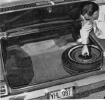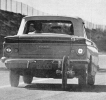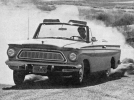
| 
|
|---|---|
| Overhead-valve Six is equipped with two-barrel Holley carburetor, which boosts basic power from 125 to 138. | American's trunk is not spacious, but has reasonable amount of room considering car's 100-inch wheelbase. |

 1963 Rambler American
1963 Rambler American
Motor Trend / February 1963
For our test we selected an American 440 convertible fitted with almost every available accessory. Their price totaled $1006.50, and for that reason its suggested total price of $3481.50 (including $131 transportation) is hardly typical of the average Rambler American sold. It does demonstrate an interesting fact about the car: people apparently want luxury features on a supposedly low-cost economy model. And it doesn't take very many of these items to pull the car right out of the low price budget.
The buyer generally gets what he asks for, and if enough requests come in for power steering and brakes, air conditioning, bucket seats, center console, and the rest of the latest automotive niceties, they'll be available. We wouldn't knock any of them. They enhanced the car -- made it more desirable. Remember, though, that a Rambler American convertible has a base price of $2344, and the car can be bought for the amount at the factory.
The American stands on a 100-inch wheelbase, a dimension that's significant for two reasons -- there's more interior space than the size would indicate, and no compromise has been made in riding comfort. Head and leg room are satisfactory. The rear seat is substantially narrower than the front because of the top mechanism. This effectively limits the car to four persons. The trunk, not exactly voluminous, does contain 23.8 cubic feet, which struck us as sufficient for all but extreme demands of carrying space.
Ride is largely a matter of personal taste. We felt it to be good. It was neither overly soft nor harsh, nor was there any of the choppiness usually associated with short-wheelbase cars. Rambler claims that much of their riding comfort can be attributed to their front suspension, which has the normal upper and lower A-arms but places the coil springs above the upper arms and above the wheels. The theory is that upward forces are absorbed directly into the body structure. Also, because the springs are above the center of gravity, they create a more stable centrifugal force condition. Rear springs are conventional leaf with tension rear shackles that provide a variable-rate suspension. It adjusts itself to load and road. The system is effective where it counts -- in the passenger compartment.
In the midst of a joyful rediscovery of floor-mounted stick shift, Rambler is now one-up on every other car. On cars equipped with overdrive and floor shifting, the driver has two levers to operate. The nearest and longest is the shift lever; alongside is a shorter stick that controls the selection of overdrive. If you prefer manual shifting, this is a pleasant way to go.
Both levers are right at hand and require no extra reach to use. We feel that this transmission has a lot to offer. When the overdrive lever is in the forward position, the transmission is a normal three-speed unit. When it's back (and it may be shifted back at any time), overdrive may be engaged at any speed above 25 to 28 mph by releasing accelerator pressure for an instant. Once in overdrive, an amber light glows on the shift console. When car speed drops below overdrive engagement speed, the car shifts itself out and the light goes off. At the lower speeds the care free-wheels and can actually be shifted without the clutch, although it's not recommended.
We were especially pleased with the overdrive kick-down feature. Normally you have to floorboard the accelerator to shift back into direct drive (true on Ramblers with column shift) -- but with Twin-Stick there's a white button atop the main shift lever. As long as there's even slight throttle pressure, a touch of this button kicks the care into direct drive. It's instantaneous and was most convenient for passing.
Shift operation was smooth, and the lever could be slammed into gear as fast as we wanted. The gate between first and second required no hesitation, and the travel was virtually a straight line. The only feature we would have liked on the transmission was a synchromesh first gear. There was audible gear clash when shifting into first, even while stopped at traffic lights.
Clutch pedal pressure is light, and the throw isn't excessively long. The clutch has a firm bite -- and we couldn't induce any slippage, even after repeated full power shifts. We were unable to get any wheelspin off the starting line, but this was a function of the limited-slip differential rather than an inadequate clutch.

| 
|
|---|---|
| Overhead-valve Six is equipped with two-barrel Holley carburetor, which boosts basic power from 125 to 138. | American's trunk is not spacious, but has reasonable amount of room considering car's 100-inch wheelbase. |
The logical conclusion is that any car should move considerably faster at top speed in overdrive than in direct. This is often not the case because most cars just plain lack the horsepower to pull the higher gear at top end.
We demonstrated this fact with the Rambler in the simplest fashion by making clocked runs in direct and in overdrive over the same mile-long straightaway. In direct third we recorded 92 mph, and that was at 4500 rpm -- the limit of the car's ability. In overdrive we reached a peak of 87 mph. The engine was turning an easy 3000 rpm (tire expansion accounts for the discrepancy in mph/1000 rpm arithmetic), but it wouldn't go any faster. Perhaps a prolonged straight run would've squeezed it to the 90-mph mark. But the point is clear -- a higher gear doesn't necessarily mean higher top speed.
The American's acceleration was hardly exciting, an expected development considering the power available. Also, the convertible is the heaviest in the series due to the stiffening X-member welded to the underside of the unit body. We did have th optional power-pack (a dual-throat carburetor worth 13 hp), but that extra punch was never intended to make a drag race contender of the car. The ohv Six is designed more for stamina than for steam.
There's ample performance to cope with traffic and freeway demands. At speeds in the highway cruising range, 60 to 65 mph, the care operated without apparent strain. We did feel that engine noise was on the high side, at least compared to most V-8s. It wasn't the sort of noise that drowns out conversation or makes radio listening impractical -- just higher than we liked.
We found handling and roadability well suited to the car's intended uses and potential speeds. Power steering is moderately geared (4 1/4 turns, lock to lock) and quite light at all times. One of the first reactions to the car is that the 17-inch-diameter wheel is oversize. You quickly get used to it, but everyone feels the same initial impression. The American understeers mildly, as it should, but it doesn't plow the front end. At high cornering speeds the car felt stable, although on fast, hard left turns the engine starved out of fuel. We reached this point in the middle of a turn, but happily there was no adverse reaction except temporary loss of power -- no tendency toward loss of control.
Ramblers are designed for rough-country use and they have something that's becoming almost extinct -- plenty of road clearance. Distance between the muffler and the ground is 6.38 inches when the car's loaded. With the optional 6.50 tires, the space increases a half-inch.
The power brakes are exceptionally light and do a first-rate job during normal stops. Our panic stopping distances were good, but we had to pump the brakes rapidly from 60 mph to minimize the lock-up, which was inevitable from high speed. We noted some pull ot the left from 60-mph stopping. It wasn't severe, but it was present. The American has self-adjusting brakes and continues with dual master cylinders. It's a good safety device; if one system fails, two-wheel braking remains.
The American's heating and air-conditioning system was one of the finest we've ever used. The sticker price of $360 places it below most other units, but we've never seen a heater that produced more heat. At its maximum it should be up to any climate. The cooling portion pumped out quantities of cold air from a dash vent that cooled the car down in good order.

| 
|
|---|---|
| Power brakes tended to lock up during panic stops. In normal traffic, brakes are sensitive and extremely light. | American has built-in understeer, normal for this sort of car. Ride, damped by Monroe shock absorbers, is surprisingly good. |
We've always wondered why more car makers haven't offered reclining seats as American Motors has for years. They're ideal for providing the passenger with an opportunity to really relax. On the convertible, they won't fold down into bed position because of the intruding rear seat armrests. The seats themselves are Rambler buckets. Their bucket effect is nominal, but they're comfortable and shaped for good back and thigh support. This year the seats are 22 inches wide, compared to 26 inches during 1962. Last year's seats were too wide for the car; edges of backrests hit the doors.
 Interior finish is good but a trifle gaudy. Seats are pleated vinyl in colors
that harmonize with the doors and floor carpets. The center console is a handy
extra storage box. Dash instruments are in front of the driver, but the American
continues the general practice of warning lights instead of gauges. (They do have
a water temp gauge.) We know there are drivers who'd like to know actual oil
pressure and be able to see alternator output or perhaps be warned if there's any
unknown drain on the battery before it's too late and the battery's dead.
Interior finish is good but a trifle gaudy. Seats are pleated vinyl in colors
that harmonize with the doors and floor carpets. The center console is a handy
extra storage box. Dash instruments are in front of the driver, but the American
continues the general practice of warning lights instead of gauges. (They do have
a water temp gauge.) We know there are drivers who'd like to know actual oil
pressure and be able to see alternator output or perhaps be warned if there's any
unknown drain on the battery before it's too late and the battery's dead.
The Rambler has fostered a public image as an economy car -- and deservedly so. During the 1962 Mobil Economy Run, a stick-shift American with the same engine as our test car (except that it was the 125-hp version with single-throat carburetor) delivered 31.11 mpg -- best figure in the event. It just isn't practical for the average motorists to look for figures on this order, though, and the two-barrel carb, power steering, and air conditioning all cost gasoline. In normal operation without special effort, the car will range between 21 and 25 mph, and that's good economy in Detroit terms.
We liked the little American. Except for the unit body, pioneered by Rambler and now in common use, it lacks fancy engineering innovation. That may be part of its charm -- a straightforward, proven design with no nonsense -- something for everyday folks.